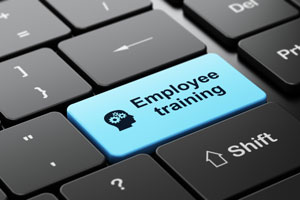Why You Need an In-House Training Program and How to Develop One
Developing an in-house training program, if done right, costs time and money — both of which are in short supply for most small businesses. However, it can help your company run more efficiently, boost productivity and increase employee retention if implemented correctly, which makes it a good investment in your future. Here are just a few ways that a training program can help you:
- Well-trained employees are more efficient, achieve more in less time, and generally make fewer mistakes.
- It helps workers keep abreast of changes in technology, in your industry, and in your market.
- Employees, especially younger ones, value career development and learning opportunities, which may help you attract and retain them.
- It can develop a pool of well-trained workers to take the place of employees who quit or retire; you can promote from within and avoid the hassle of recruiting outside the company.
How to Prepare
If you are interested in developing a training program, it's wise to take some time to assess where the training gaps are. Do all employees know the ins and outs of your products and services so they can explain them to customers? Is everyone up to speed on the technology and software you use? Could training help your outside sales representatives increase their output? Get with your supervisors and team leaders and have them identify areas that would be helped by a training program. Be sure to explain the benefits and get their buy-in before beginning. Otherwise, you're likely to face complaints when their team members are taken away from day-to-day duties to attend training sessions.
What Are Your Options?
-
In-House Trainers
Do you already have staff members who would be good trainers? Remember, they must have communication skills in addition to technical knowledge. Can they speak in front of a group? Are they organized enough to develop a lesson plan? Do they have the people skills to make learning interesting and non-threatening? If you don't have an employee who can do a great job training, it may be better to call in outside help, because the last thing you want to do is make your staff think training is worthless and/or boring.
If you're lucky enough to find someone who makes a good in-house trainer, make it worth their while to take on the additional duties of training others: give them a bonus or a promotion and make sure they get the recognition they deserve. Consider sending them to outside conferences or workshops so they can share what they've learned with the rest of the staff.
-
Brown-Bag Lunches
This option will work for any size company. Once a month or oftener, organize an informal meeting where one employee or a team shares what their department does, something they've recently learned, etc. Provide pizza or sandwiches and drinks, and encourage two-way communication. Be sure to attend in person so everyone knows you see the value of these meetings. This kind of gathering also helps develop a sense of teamwork among employees who may not otherwise have much interaction.
-
One-to-One Training
Mentoring, in which a seasoned employee volunteers to take someone less experienced under their wing, can have benefits for both parties. The mentee learns the ins and outs of company culture and history in addition to specific job knowledge and can be put on the path toward career advancement. The mentor feels valued for their knowledge and experience and can develop communication and teaching skills.
In job shadowing, one employee follows another through the course of a workday, or longer if desired, getting a first-hand look at how their duties are performed. It can be used either as part of a new hire's orientation or as a valuable component of a cross-training program. Find out more about job shadowing.
Create a Curriculum
Developing a "curriculum" may sound like a daunting task, but it's really just a collection of training resources that are organized in a logical way. Whenever you have formal training, record it on video, which is easy to do with today's cameras or even a smartphone. Create a folder for this training on the company computer, and put the video in it, as well as digital copies of any materials handed out. If a PowerPoint presentation was used, include that as well.
If you or a team member attend a conference or seminar with information others can use, create a folder for that. Read a great article in an industry publication that you'd like to share with your team? Scan it into your training folder. You'll be surprised how quickly you can build up a library of training materials at little or no cost.
Create a system to organize your materials. Some may be appropriate for new-hire orientation, others for technical knowledge, and others for general training on subjects like customer service or time management. By making training a priority and investing some time and money in it, you'll be well on your way to a more efficient workplace, a happier team, and a healthier bottom line.
Stay in the know!
Join our newsletter for special offers.
 Do you already have staff members who would be good trainers? Remember, they must have communication skills in addition to technical knowledge. Can they speak in front of a group? Are they organized enough to develop a lesson plan? Do they have the people skills to make learning interesting and non-threatening? If you don't have an employee who can do a great job training, it may be better to call in outside help, because the last thing you want to do is make your staff think training is worthless and/or boring.
Do you already have staff members who would be good trainers? Remember, they must have communication skills in addition to technical knowledge. Can they speak in front of a group? Are they organized enough to develop a lesson plan? Do they have the people skills to make learning interesting and non-threatening? If you don't have an employee who can do a great job training, it may be better to call in outside help, because the last thing you want to do is make your staff think training is worthless and/or boring. Developing a "curriculum" may sound like a daunting task, but it's really just a collection of training resources that are organized in a logical way. Whenever you have formal training, record it on video, which is easy to do with today's cameras or even a smartphone. Create a folder for this training on the company computer, and put the video in it, as well as digital copies of any materials handed out. If a PowerPoint presentation was used, include that as well.
Developing a "curriculum" may sound like a daunting task, but it's really just a collection of training resources that are organized in a logical way. Whenever you have formal training, record it on video, which is easy to do with today's cameras or even a smartphone. Create a folder for this training on the company computer, and put the video in it, as well as digital copies of any materials handed out. If a PowerPoint presentation was used, include that as well. 
